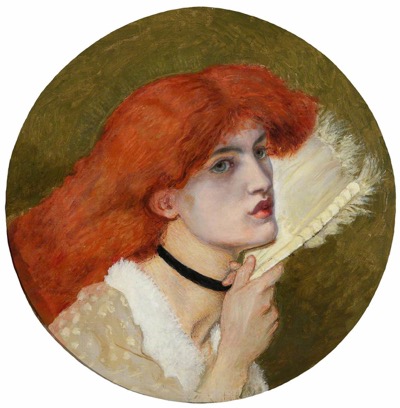Mrs William Morris is an oil-on-canvas portrait by Dante Gabriel Rossetti. The head and shoulders portrait was painted from 1870 to 1893. The diametre of the painting is 480 millimetres.
In 1857, Rossetti discovered Jane Burden while working with his associates on the Pre-Raphaelite Brotherhood murals in the Oxford Union building. Burden agreed to model for the artist, who chose the woman because of her striking appearance. Burden's strong features, as well as her thick, dark, frizzy hair plus eyebrows, were the opposite of the modern ideal of a soft, rounded face and meticulously arranged straight hair. Burden modelled for many of Rossetti's paintings and drawings.
The woman in the painting is wearing a spotted dress that has white fur collar. A black ribbon is tied around the woman's neck; in her right hand, she is holding a white fan behind her neck. Instead of her own black hair, she's having Elizabeth Siddal's flowing red hair. This composite portrait was Lady Mander and Sir Geoffery's first significant Pre-Raphaelite acquisition, purchased before the National Trust had officially received Wightwick. Rossetti's face was painted in the 1870s and the rest of the painting, including Rossetti's red hair, was executed by Ford Madox Brown, a British painter of historical and moral subjects.
On April 17 1937, Helen Rossetti Angeli, Gabriel Arthur Rossetti's sister wrote a letter to Sir Geoffrey about this painting stating that his uncle didn't finish the head. After his death, it came into her mother's hands. Shortly before her father's death, her mother got Madox Brown to finish the portrait. Brown painted the red hair. The hair of the woman in the painting, Jane Morris, was black and waved. The contrast between the red hair of the painting and dark eyebrows is quite marked. Maybe Brown was intentionally hinting at Rossetti's earlier attraction to stunners with red hair, especially Lizzie Sidda.
The difference that the two artists used is also apparent. The face brushwork is smooth and contrasts with the rougher and crude treatment of the fan, hand and ear. The flesh tones are markedly different as well. In the last years of Brown's life, he was suffering from a stroke, forcing him to continue painting with his left hand.




